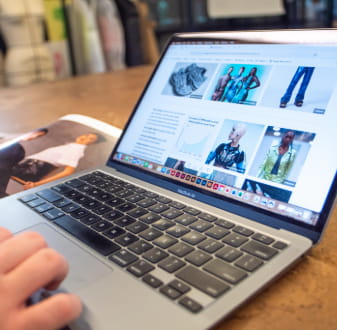In addition to running her own freelance photography and videography business, Milly Mead Photography, she’s also an award winner – taking out Highly Commended in Capture Magazine’s Top Emerging Photographers after photographing humpback whales in Tonga for two weeks.
At our recent Design Career Talks event on Ultimo campus, the Diploma of Photography and Photo Imaging graduate generously shared her insights on how to become a freelance photographer and her experience studying at Billy Blue College of Design at Torrens University Australia.1. Hands-on experience is key
“There are so many YouTube tutorials online, but I really like education and connection with people. As soon as I came to Billy Blue, l met a lecturer and he remembered my name from an info night. That was so different to my last course, and I could really see how tangible, hands-on experience was invaluable. It gave me way more than anything online. To have the connection with people who were working in the industry and have the experience was really important.”
2. Work while you study
“When I finished the course, I rolled straight into working for myself. The most valuable thing I learned from my lecturers was to start picking up work while I was studying, so that when I graduated it was a real flow for me to get into. I already had clients.”
3. Try it all
“I don’t know what I would have done without having the training wheels or a safe environment to try things. I was encouraged by my lecturers to take on opportunities outside of the classroom, so I assisted a domestic photographer taking photos of kids and families. I found I really didn’t like that, so I could put that aside and move into commercial, which was more of a natural fit for me. By the end of it I knew that was what I wanted to do.”
4. A can-do attitude goes a long way
“I looked at photographers in Sydney and compiled a list of people. It was a pretty bold move at the time, but I emailed or called them and said, ‘Hey I’m a student and I’d like to assist you.’ A couple of them wrote back, so straight out of uni I had a few assisting jobs. The industry in Sydney is quite small, so from that I’ve found my number gets passed on. Do a good job, turn up with a smile on your face and be confident, because assisting is about having a can-do attitude. From that I’ve built this network and I’m working as both an assistant and a photographer.”
5. Never stop networking
“If you’re turning up to class on time, if you’ve got a positive attitude, if you’re even just submitting your assignments with integrity and putting your full effort into it, people are going to notice and pass on your number. That’s how I got started, utilising the network that I already had here. I blatantly told my lecturers to give me work. You’ve got to be extremely proactive – you can’t just wait for the work to come to you.”
6. Use your portfolio as a chance to reflect
“It can be confronting to put together this work that’s going to be what you go out to the industry with. What I found, though, was that it was a really good exercise for me to reflect on what I wanted to do. It’s a really good marker to say, ‘I need to update it.’ A good benchmark for me to have industry come in and critique it. I’m actually right now in the process of updating my portfolio and I have somewhere to go from, already having that uni experience.”
7. Don’t underestimate the power of video
“Video is so important. It’s been so important to integrate that into my business because there’s demand for it. We did a motion design class in trimester three. That was my first foray into video and since then I’ve really tried hard to keep upskilling, and surround myself with videographers so I can continually learn and educate myself.”
8. Don’t forget to stretch
“Clients will ask for these things that I’m like, ‘Oh yeah, I can do that’, and then I go google it. It’s just about saying yes and stretching yourself a little bit … to make sure that I’m staying ahead of the game.”
9. Treat your assignments like a job
“While I was studying, I got really into my calendar because I was balancing four different classes, different deadlines, different assessments – that’s exactly what my job looks like right now. I’m prepping for a shoot next week, I’m editing four projects from last week, I’m shooting tomorrow so I’ve got to have my gear prepped. Take on assessments like they’re a job: time management, organisation, interacting with people.”
10. There’s power in the people around you
“What I needed to hear before I started studying and to some degree when I started studying was utilise the people around you because they want you to do your best. The lecturers here, the staff here, the other students – everybody wants you to do a great job and they’ll support you.”
11. Make the time to experiment
“At Billy Blue, there’s a studio downstairs in Sydney as well as a cache of equipment that you can borrow. I was trying to be in that studio every weekend, just playing around or taking a friend with me and experimenting with lighting. Once I started to take on the jobs that my lecturers were putting me forward for, I could borrow the equipment that’s here and experiment with it, work out how to use it and then borrow that for jobs as well, which was invaluable.”
Want more? Here's Milly Mead's full interview at our Design Career Talks:




